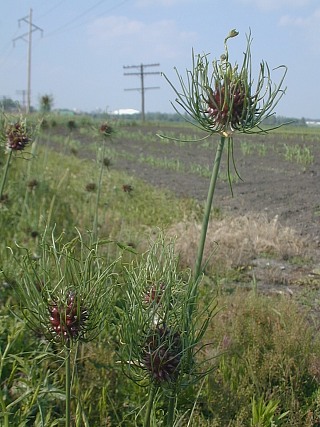Description: This herbaceous perennial plant is 1-3' tall and unbranched. The central stem is round and hairless. Sometimes the lower stem becomes draped with the membranous sheaths of the outer layers of its skin and former leaves. These sheaths are brittle, light brown, and dried out. Along the lower half of the stem, there are a few alternate leaves that are up to 10" long and ¾" across at the base. They are linear and sword-shaped, hollow on the inside toward the base, and hairless. Relative to the stem, these fragile and rather floppy leaves are semi-erect, but they often bend at the middle or at the base. Each leaf is more or less round in circumference, becoming slightly flattened on the upper side toward the base, where it wraps around the stem.

The
central stem terminates in a long naked stalk of flowers and/or aerial
bulblets. Usually, a sessile cluster of aerial bulblets is produced; a
few flowers on slender pedicels may appear above the bulbets. On rare
occasions, an umbel of flowers will develop without bulblets.
Regardless of whether flowers or bulblets are produced, the mature
inflorescence is about about 2-3" across. During an early stage of
development, the entire inflorescence is covered by a sack-like
membrane that is rounded at the bottom and pointed at the top. This
membrane splits open to release the bulbets and/or flowers. A dried
remnant of this membrane usually persists at the base of the
inflorescence. The bulblets are green to dark red, about 1/3" (8 mm.)
long, and
ovoid. Each bulblet has a long green tail that is about 1" long. The
small flowers are green, white, or light purple. Each flower is about
¼" long, consisting of 6 tepals that are erect or slightly spreading.
The blooming period can occur from late spring to mid-summer and lasts
about 2-3 weeks. While the flowers are not noticeably fragrant, the
foliage has a strong garlic aroma. Each flower is replaced by a
3-celled capsule containing several small black seeds. The root system
consists of a bulb with secondary roots. Bulblets are often formed
underground as offsets of the mother plant. This plant usually
reproduces vegetatively by means of the aerial and
underground
bulblets, but it can also reproduce by seed when flowers are produced.
This plant often forms colonies of variable size.
vegetatively by means of the aerial and
underground
bulblets, but it can also reproduce by seed when flowers are produced.
This plant often forms colonies of variable size.
Cultivation:
This plant thrives in full or partial sun, moist to slightly dry
conditions, and a heavy soil containing some clay. However, other kinds
of soil are tolerated as well. This plant can spread aggressively and
is difficult to get rid off. Occasionally, it invades lawns, especially
when mowing is performed on an irregular basis.
Range & Habitat:
Field Garlic is a common plant that occurs in every county of Illinois.
It is native to Eurasia. Habitats include prairie remnants and other
areas along railroads, degraded meadows near rivers or woodlands,
woodland borders and thickets, vacant lots, grassy clay banks, poorly
maintained lawns, and waste areas. While this plant is usually found in
degraded habitats, it also occurs occasionally in natural habitats,
where it can become a pest.
Faunal Associations:
The nectar of the flowers attracts small bees and flower flies. Insects
feeding on the bulbs of Allium spp. (Onions)
include the maggots of Delia platura (Bean Seed
Fly) and Delia antiqua (Onion Fly), while various Frankliniella
spp. (Thrips) feed on the foliage. Although mammalian
herbivores usually avoid this plant, it is sometimes eaten along with
the grass by cattle. In the case of dairy cattle, this can result in
milk with a disagreeable odor. The ecological value of this plant to
fauna is low.
Photographic Location:
A grassy bank at the edge of the Red Bison Prairie in Savoy, Illinois.
The inflorescences of the photographed plants are dominated by reddish
aerial bulblets and their developing green shoots.
Comments:
Field Garlic is the most aggressive Allium sp. in
Illinois. Unlike the native Allium spp., it has
leaves that are hollow at the base. Among the introduced Allium
spp., some species produce only flowers, while others produce
aerial bulblets primarily. Field Garlic belongs to this latter group.
In this regard, it is similar to Allium sativum
(Cultivated Garlic), but the aerial bulblets of Field Garlic have much
longer green tails with a striking appearance. While its bulblets can
be used to season food like Cultivated Garlic, they have a strong
flavor.